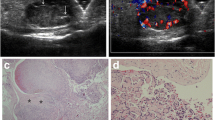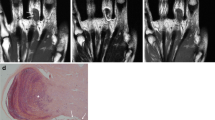Abstract
Objective
To describe magnetic resonance imaging (MRI) and ultrasound (US) findings of intravascular papillary endothelial hyperplasia (IPEH) arising in extremities.
Materials and Methods
Six patients with IPEH confirmed by surgical resection were reviewed retrospectively. Before resection, 3 patients underwent both MRI and US and 3 patients underwent only MRI. Two radiologists retrospectively reviewed MR/US imaging results and correlated them with pathological features.
Results
The 6 IPEHs were diagnosed as 4 mixed forms and 2 pure forms. The pre-existing pathology of four mixed forms was intramuscular or intermuscular hemangioma. By MRI, the mixed form of IPEH (n = 4) revealed iso- to slightly high signal intensity containing nodule-like foci of high signal intensity on T1-weighted images (T1WI) and high signal intensity-containing nodule-like foci of low signal intensity on T2-weighted images (T2WI). The pure form of IPEH (n = 2) showed homogeneous iso- signal intensity on T1WI and high and low signal intensity containing nodule-like foci of low signal intensity on T2WI. On gadolinium-enhanced fat-suppressed T1WI, 50% of cases (n = 3: mixed forms) revealed peripheral, septal, and central enhancement. The other IPEHs (n = 3: 1 mixed and 2 pure forms) showed peripheral and septal enhancement or only peripheral enhancement. By US, two mixed forms of IPEH showed well-defined hypoechoic masses containing hyperechoic septa and central portion with vascularities. One pure form of IPEH was a homogeneous hypoechoic mass with septal and peripheral vascularities on color Doppler imaging. The foci of high signal intensity on T1WI, foci of low signal intensity on T2WI, and non-enhancing portions on MRI and the hypoechoic portion on US were histopathologically correlated with thrombi and the peripheral/septal or central enhancing areas on MRI, hyperechoic septa and the central portion on US, and septal/central or peripheral vascularities on color Doppler imaging corresponded to hypertrophic papillary epithelium and a fibrovascular core.
Conclusions
Even though imaging findings of the pure form of IPEH are rather nonspecific, the mixed form of IPEH should be considered a possible diagnosis when a well-defined mass with T2 hyperintense signal containing nodule-like foci of low signal intensity, T1 iso- to slightly hyperintense signal containing nodule-like foci of high signal intensity, and peripheral/septal or central enhancement on MRI is seen in extremities, along with the US finding of a hypoechoic mass containing hyperechoic septa with vascularities.



Similar content being viewed by others
References
Clearkin KP, Enzinger FM. Intravascular papillary endothelial hyperplasia. Arch Pathol Lab Med. 1976;100:441–4.
Masson P. Hemangioendotheliome vegetant intra-vasculaire. Bull Soc Anat Paris. 1926;93:517–23.
Elder DE, Elenitsas R, Bernett L, Johnson J, Murphy GF, Xu X. Lever’s histopathology of the skin. Philadelphia: Lippincott Williams & Wilkins; 2008.
Hashimoto H, Daimaru Y, Enjoji M. Intravascular papillary endothelial hyperplasia. A clinicopathologic study of 91 cases. Am J Dermatopathol. 1983;5:539–46.
Kretner A, Smith RM, Trefny FA. Intravascular papillary endothelial hyperplasia: light and electron microscopic observations of a case. Cancer. 1978;42:2304–10.
Levere SM, Barsky SH, Meals RA. Intravascular papillary endothelial hyperplasia: a neoplastic “actor” representing an exaggerated attempt at recanalization mediated by basic fibroblast growth factor. J Hand Surg. 1994;19:559–64.
Pins MR, Rosenthal DI, Springfield DS, Rosenberg AE. Florid extravascular papillary endothelial hyperplasia (Masson’s pseudoangiosarcoma) presenting as a soft-tissue sarcoma. Arch Pathol Lab Med. 1993;117:259–63.
Yamamoto T, Marui T, Mizuno K. Recurrent intravascular papillary endothelial hyperplasia of the toes. Dermatology. 2000;200:72–4.
Lee S, Suh J-S, Lim B, Yang W, Shin K-H. Intravascular papillary endothelial hyperplasia of the extremities: MR imaging findings with pathologic correlation. Eur Radiol. 2004;14:822–6.
Clifford P, Temple HT, Jorda M, Marecos E. Intravascular papillary endothelial hyperplasia (Masson’s tumor) presenting as a triceps mass. Skeletal Radiol. 2004;33:421–5.
Juan Y-H, Huang G-S, Chiu Y-C, Chang W-C, Hsu Y-C. Intravascular papillary endothelial hyperplasia of the calf in an infant: MR features with histological correlation. Pediatr Radiol. 2009;39:282–5.
Schwartz SA, Taljanovic MS, Harrigal CL, Graham AR, Smyth SH. Intravascular papillary endothelial hyperplasia: sonographic appearance with histopathologic correlation. J Ultrasound Med. 2008;27:1651–3.
Murphey MD, Gibson MS, Jennings BT, Crespo-Rodriguez AM, Fanburg-Smith J, Gajewski DA. From the archives of the AFIP: imaging of synovial sarcoma with radiologic-pathologic correlation. Radiographics. 2006;26:1543–65.
Acknowledgement
This work was supported by the 2004 Inje University Research Grant and Busan Paik Hospital Imaging Research Institute.
Author information
Authors and Affiliations
Corresponding author
Rights and permissions
About this article
Cite this article
Lee, S.J., Choo, H.J., Park, J.S. et al. Imaging findings of intravascular papillary endothelial hyperplasia presenting in extremities: correlation with pathological findings. Skeletal Radiol 39, 783–789 (2010). https://doi.org/10.1007/s00256-010-0888-2
Received:
Revised:
Accepted:
Published:
Issue Date:
DOI: https://doi.org/10.1007/s00256-010-0888-2




